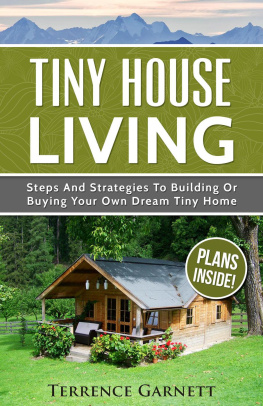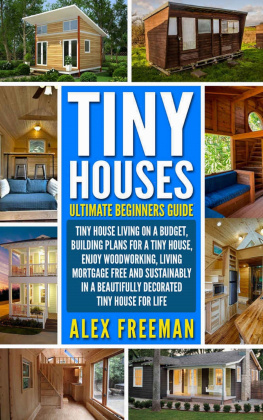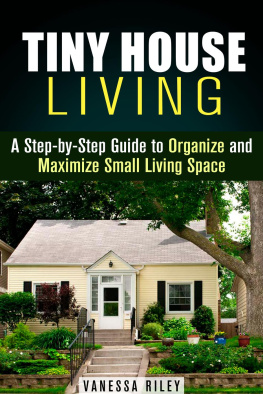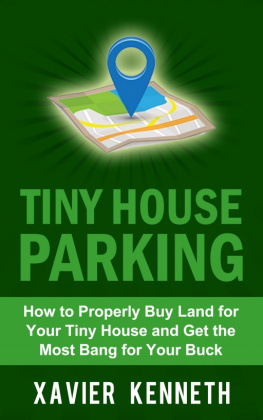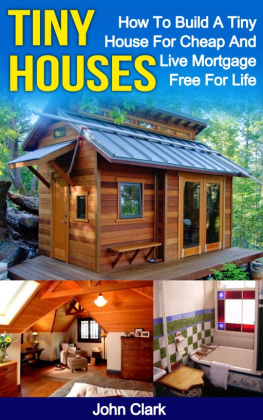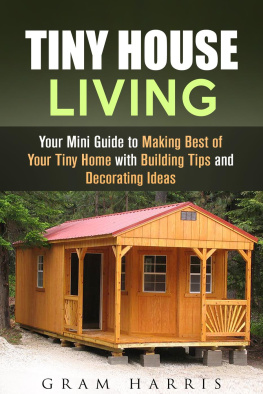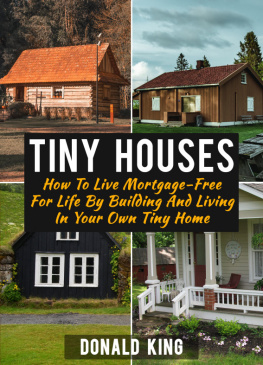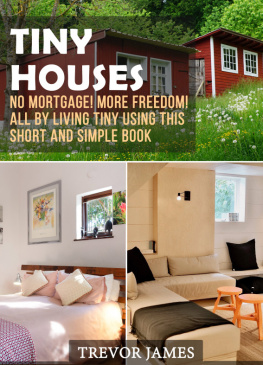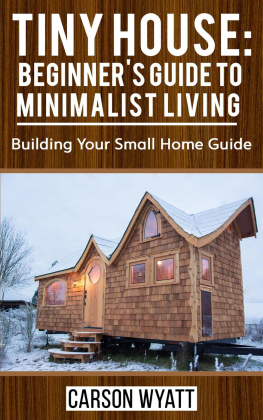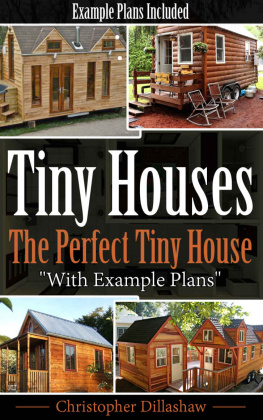Tiny House Living
Steps And Strategies To Building Or Buying Your Own Dream Tiny Home
Terrence Garnett
Table of Contents
T hank you for taking the time to download this book, Tiny House Living.
This book covers the topic of Tiny Houses, and will teach you how you can own one yourself.
At the completion of this book, you will have a good understanding of the Tiny House Movement and lifestyle and be able to make the right decisions in building or buying your very own tiny house.
This book is full of fun facts and important tips for those who are considering owning a Tiny House.
To be specific, you will get to know the Tiny House Movement and the figures related to tiny house living based on statistics. In addition, you will be given the pros and cons of this lifestyle, so you can set realistic expectations. You will also get some help in choosing between building your own tiny house or buying one from a professional builder.
If you do prefer to build your own tiny house, an entire chapter is dedicated to helping you get an overview of what you will need. On the other hand, should you choose to buy one, you will find another chapter that can help you make the best choice.
It does not end there, though. You will also gain plenty of fun and practical space-saving hacks and furniture ideas to make your tiny house comfortable, stylish and convenient to use. The book then ends with a chapter, which answers the most Frequently Asked Questions regarding tiny houses.
Living in a tiny house is ideal for those who wish to become financially free, environment-friendly, and self-supporting. You can begin taking the steps to become a part of the Tiny House Movement right now. All you have to do is start with Chapter 1!
Once again, thanks for downloading this book, I hope you find it to be helpful!
Chapter 1 Origins of the Tiny House
W elcome to the first chapter of Tiny Houses. Here, you will learn some general information about tiny houses as well as the movement and its background.
It should be noted that the idea of living in a tiny house is not a novel thing. In fact, humans have been living in small abodes for millennia. However, when people talk about tiny houses in the 21st century, they may be referring to the social and architectural movement, which promotes living in small homes. It is called the tiny house movement.
How the Tiny House Movement Began
It has been observed that in some countries, particularly the U.S., the usual size of homes has grown to almost twice the normal size since fifty years ago. For instance, in 1978, the average American home covered 1,780 sq. ft. of space, but in 2013, it grew to 2,662 sq. ft. Many tiny house owners believe that this leads to overconsumption of materials goods to fill up the excessive space, although much of these items end up as clutter or thrown away unused.
Due to these reasons, the Tiny House Movement began to grow as a global community of people who wish to return to living in homes built below 1,000 sq. ft. Their reasons for doing so vary, but the most common include promoting self-sustained living, living mortgage-free, and maintaining environment-friendly and anti-consumerist lifestyle.
Among the pioneers of this movement are Lloyd Kahn, who wrote and published Shelter in 1973; Lester Walker, who published Tiny Houses in 1987; Sarah Susanka, the author of a 1997 publication entitled The Not So Big House. However, the man behind the concept of a tiny house on wheels is Jay Shafer, who founded the Tumbleweed Tiny House Company in 2002 and Four Lights Tiny House Company in 2012.
Shafer, together with Nigel Valdez, Shay Salomon and Greg Johnson, also organized and started the Small House Society in 2002. This propelled Salomon and Valdez to write and publish Little House on a Small Planet in 2006, which is a guide to living in small houses in the 21st century. Johnson, on the other hand, wrote and published Put Your Life on a Diet in 2008, an autobiographical account of living in a tiny house.
Tiny houses also serve a worthwhile purpose as part of the recovery projects after major natural and financial disasters. For instance, Marianne Cusato built the Katrina Cottages in 2005 to provide shelter to victims of Hurricane Katrina. These tiny houses were built at a little over 308 sq. ft. Tiny houses sparked interest on a broader scale during the financial difficulty in 2008, as people began to turn to Accessory Dwelling Units (ADUs) for relatives and friends who needed more affordable abodes.
Common Concerns regarding Tiny House Living
To date, an increasing number of people have grown interested in owning their own tiny house as their primary or secondary home. Because of this, more builders have also sprouted, although some of whom are not experienced enough to construct sustainable and durable homes. This led many to feel concerned about the safety of living in a tiny house built by amateurs.
In an effort to promote safety guidelines in tiny house building and living, a group of professional builders formed an alliance in 2013 to create formal guidelines on ethical practices in the construction of tiny houses on wheels. This led to the development in the nonprofit organization called the American Tiny House Association, which further promoted this movement, in 2015.
Aside from that, another common concern among tiny house owners and builders is the challenge of zoning laws. Most areas require a minimum square footage for the construction of houses on a foundation and on wheels. Some areas even prohibit building a tiny house on ones own property. In addition, some RV trailer parks do not allow entry to tiny houses on wheels.
On the bright side, more states are now looking to update their zoning regulations to accommodate tiny houses. One such area is Spur, Texas, which is regarded as the first town to welcome tiny houses in 2014. The second state to open their doors to tiny houses is Washington County, Utah, who updated their zoning laws in 2016 to allow specific tiny house designs to be built in the area.
Tiny House Facts
Here we will talk about some pertinent figures that you may be interested to know regarding the Tiny House Movement.
First is that the typical tiny house is approximately 186 square feet, while the typical traditional U.S. house covers 2,100 square feet. However, according to several sources such as the United States Census Bureau and the National Association of Home Builders, about eighty-nine percent of tiny house owners have lower credit card debts compared to the average American, with sixty-five percent of them owning zero credit card obligations.
In terms of mortgage and savings, sixty-eight percent of tiny house owners do not have any mortgage, compared to almost 30 percent of regular homeowners in the U.S. Moreover, seventy-eight percent of these tiny house owners actually own their abode, while only 65 percent of traditional homeowners do. Another fact is that over fifty percent of tiny house owners have an average of $10,900 in savings, significantly more than that of the average U.S. citizen.
Next page
